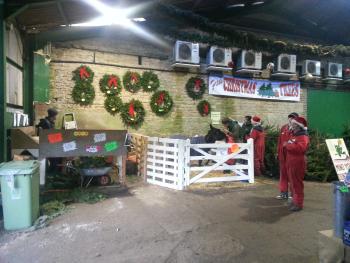
 Christmas trees. You plant ‘em, they grow for a few years, you chop ‘em down and shove em in your living room for a few short weeks. By the time the needles start to fall off their job is done and they are consigned to the pile of rubbish at the bottom of the garden. Right?
Christmas trees. You plant ‘em, they grow for a few years, you chop ‘em down and shove em in your living room for a few short weeks. By the time the needles start to fall off their job is done and they are consigned to the pile of rubbish at the bottom of the garden. Right?
Well no not really. There is science in growing Christmas trees. Technology even! As you may know I live in a very agricultural county where we are experts on growing things and in the small rural hamlet of Fillingham they grow them in their tens of thousands.
Fillingham Trees grow a hundred acres of them divided between Nordman, Norway, Blue Spruce and Lodgepole pines. In the dim and distant past I played a few games of rugby with owner William Rose (pictured right) and I met him at his farm in Fillingham to chat about the growing business of growing Christmas trees.
 Did you know it takes 8 – 10 years to grow a 6 foot Nordman Fir? The Nordman represents 80% of the market because it doesn’t drop its needles. Also these trees don’t “just grow”. They are shaped, manually over the course of their growing life. Growth inhibitors are applied twice a year and once a year the middle bud from each new branch is nipped out so that the tree spreads into a nice shape. That happens to each tree individually and with around 7,000 trees to the hectare that’s roughly 280,000 trees hand pruned, every year!
Did you know it takes 8 – 10 years to grow a 6 foot Nordman Fir? The Nordman represents 80% of the market because it doesn’t drop its needles. Also these trees don’t “just grow”. They are shaped, manually over the course of their growing life. Growth inhibitors are applied twice a year and once a year the middle bud from each new branch is nipped out so that the tree spreads into a nice shape. That happens to each tree individually and with around 7,000 trees to the hectare that’s roughly 280,000 trees hand pruned, every year!
Norway’s are cheaper because they grow more quickly. It’s easy to work out that with all the manual care in the case of Christmas trees, time in the ground actually does represent a cost.
The seeds for these trees come from mountainsides in northern Russia. At Fillingham they plant their trees as 15cm high transplants bought in from a nursery as opposed to growing them from seed. They plant thousands in a day using specialist tree planting kit.
Growing Christmas trees is a very competitive business. We buy 7 million of them a year in the UK and a lot of farmers will want a piece of the action. At Fillingham they employ innovative marketing techniques that include a Facebook page. The season opened this year on 24th November and for two weeks punters have been able to ride around the farm on a tractor trailer to choose their own tree. The tree of choice is then labelled ready for cutting down and collection at a time that suits the customer. Innovative.
 Their ultimate success though is based on producing a quality product year after year and this is reflected in their wholesale sales of between 20,000 and 25,000 trees shipped to places as far as the Gower Peninsula in South Wales. Wow!
Their ultimate success though is based on producing a quality product year after year and this is reflected in their wholesale sales of between 20,000 and 25,000 trees shipped to places as far as the Gower Peninsula in South Wales. Wow!
In one sense the Christmas tree is the ultimate genetically modified product. Many seeds come from the same “mother” tree so in theory they should all look the same. Nature doesn’t work like that though and many trees grow malformed, perhaps because of the weather or animal damage. Nordmans are also affected by needle necrosis which can turn the needles brown overnight and render the tree unsaleable.
Just like we like our fruit and veg in perfect condition we have the same attitude towards our Christmas trees. Imperfect trees are left in the ground and at the end of the season mulched and ploughed back into the soil. Brutal! 🙂
Anyway that’s about it on Christmas trees other than to introduce the following two videos. The first is how to “net” a tree for transportation using a mechanised tree netter. The second is how to net a boy for a laugh using a manual netter. You know it makes sense.
Good luck to Fillingham trees and thanks to William for the guided tour. I hope their season goes well and they enjoy a well-earned Christmas break.